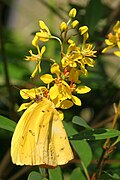| Cloudless sulphur | |
|---|---|
 | |
| Male P. s. sennae, Tobago | |
 | |
| Female P. s. sennae, Tobago | |
| Scientific classification | |
| Kingdom: | Animalia |
| Phylum: | Arthropoda |
| Class: | Insecta |
| Order: | Lepidoptera |
| Family: | Pieridae |
| Genus: | Phoebis |
| Species: | P. sennae |
| Binomial name | |
| Phoebis sennae | |
| Subspecies | |
Three, see text | |
| Synonyms | |
Papilio sennae | |

Phoebis sennae, the cloudless sulphur, is a mid-sized butterfly in the family Pieridae found in the Americas. There are several similar species such as the clouded sulphur ( Colias philodice ), the yellow angled-sulphur ( Anteos maerula ), which has angled wings, the statira sulphur ( Aphrissa statira), and other sulphurs, which are much smaller. The species name comes from the genus Senna to which many of the larval host plants belong.











